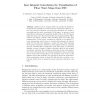Free Online Productivity Tools
i2Speak
i2Symbol
i2OCR
iTex2Img
iWeb2Print
iWeb2Shot
i2Type
iPdf2Split
iPdf2Merge
i2Bopomofo
i2Arabic
i2Style
i2Image
i2PDF
iLatex2Rtf
Sci2ools
MICCAI
2002
Springer
2002
Springer
Line Integral Convolution for Visualization of Fiber Tract Maps from DTI
Abstract. Diffusion tensor imaging (DTI) can provide the fundamental information required for viewing structural connectivity. However, robust and accurate acquisition and processing algorithms are needed to accurately map the nerve connectivity. In this paper, we present a novel algorithm for extracting and visualizing the fiber tracts in the CNS specifically, the spinal cord. The automatic fiber tract mapping problem will be solved in two phases, namely a data smoothing phase and a fiber tract mapping phase. In the former, smoothing is achieved via a weighted TVnorm minimization which strives to smooth while retaining all relevant detail. For the fiber tract mapping, a smooth 3D vector field indicating the dominant anisotropic direction at each spatial location is computed from the smoothed data. Visualization of the fiber tracts is achieved by adapting a known Computer Graphics technique called the line integral convolution, which has the advantage of being able to cope with singula...
| Added | 15 Nov 2009 |
| Updated | 15 Nov 2009 |
| Type | Conference |
| Year | 2002 |
| Where | MICCAI |
| Authors | Tim McGraw, Baba C. Vemuri, Zhizhou Wang, Yunmei Chen, Murali Rao, Thomas Mareci |
Comments (0)

